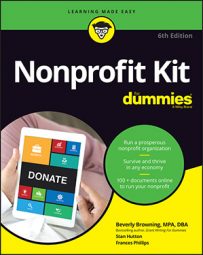This effort is likely to have three phases:
- Planning for your needs
- Identifying possible locations
- Analyzing the feasibility of the locations you find
How much space and of what kind?
Before you go out to seek a location, make a list of your organization’s specific needs. If you’ve ever shopped for an apartment or house, you know that some features are critically important and some are desired but not essential. Breaking down your space needs by function and then including a list of general requirements helps. Consider current programs as well as programs you’re planning to introduce in the near future.For help in anticipating and specifying all your organization’s facility needs, check out the Nonprofit Kit page at Dummies.com.
Location, location, location
Many nonprofit organizations have learned the hard way that having a beautiful new facility doesn’t necessarily mean that their students, patients, or audiences will go there. An organization should conduct a simple marketing test of a location it’s considering. This “test” may take the form of a written survey, interviews, or an open house/walk-through at the proposed site followed by a discussion with current constituents.Also, talk to nearby residents, merchants, and the local police, and spend time observing the site at different times of day. Finally, check the zoning for the desired location and make certain that the use you propose for it is permitted.
Organizations often move to larger facilities when they want their programs to grow, and they discover the hard way that offering more seats, classes, or therapy sessions doesn’t necessarily mean that they’ll be used. Do you have clear evidence of growing demand for your services and that your organization’s current physical space is inhibiting its growth? When you conduct your marketing test, you need to discern whether more people will go to your new location: Reach out to both potential clients and your current followers.
Your ideal location may change over time as neighborhoods change. Even if your organization has been based in one place for a long time, before signing a new lease, explore whether its location is still meeting its needs.
Owning, leasing, or taking a free ride
Stability, convenience, and cost — in addition to location — are key factors to consider when selecting your organization’s home.In considering your real-estate choices, also consider your context. Is the real estate market changing? Are interest rates rising or falling? How well are tenants’ rights protected by law? Is the building that you want to lease likely to be sold?
The pros and cons of owning
Because of the tax benefits of private homeownership, many people assume that owning a building is best for a nonprofit organization. Although a nonprofit’s building can be a valuable asset, remember that a nonprofit is already exempt from paying most business taxes, so any interest it may pay on a mortgage or building loan isn’t a deductible expense — it’s just an expense.Two possible advantages of building ownership include:
- Ownership stabilizes costs. If your organization is based in a real estate market where prices are rising, purchasing a building may help to prevent steep rent increases or an untimely eviction.
- Ownership improves the public image of your organization. Organizations owning their own buildings appear in the public eye to be stable institutions. This perception may help them raise money.
Whether or not it has tenants, it becomes fully responsible for the building’s care. Rental income it collects can be an unrelated business taxable income. Check with a tax attorney for advice before entering into this type of arrangement.
If your nonprofit organization buys its own building, be sure to set aside a cash reserve for building maintenance. Otherwise, if a boiler explodes or the roof leaks, you may have to suspend operations for an extended period of time to fix the problem.
Considering renting
When you rent a home for your nonprofit organization, you’re taking on costs that you need to cover month after month. Often these costs increase from year to year. Rent may not be the only such expense. Here are a few things you want to understand fully before signing a lease:- What costs are covered? Is your nonprofit responsible for all or some of the utilities?
- How long is the lease and does it include options for you to renew it at a similar rate?
- If property or other taxes increase while you’re a tenant, do you pay for the increase or does the landlord?
- Which repairs are the landlord’s responsibilities and which ones are yours?
- Who’s responsible for routine building maintenance?
- What will the landlord permit you to change about the building?
Deciding whether to take a freebie if it’s offered
Taking a free ride through the donation of space sounds wonderful, doesn’t it? Indeed, it lowers your operating costs and enables you to use more of your resources for programs. But you must be willing to look a gift horse in the mouth.A free building is worthwhile only if it’s in the right location, is the right size, and offers the right amenities. Doing effective work is very difficult in an inappropriate space. Ask yourself this: If the building weren’t free, would you have chosen it for your nonprofit?
Making a move
Organizations with what seem to be straightforward plans for moving into new facilities often overlook the true costs of making such a move. Some spaces may need to be altered to suit your organization’s needs. Even when you fit right into your new offices, you encounter one-time charges such as signs, cleaning deposits, phone and Internet hookups, and fees or deposits for starting up your utilities. Don’t forget marketing costs to let the public know you have moved.The most important things for you to move are your constituents. You want to make a thoughtful, sustained effort to invite them into your new facility.

